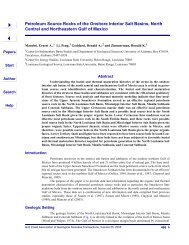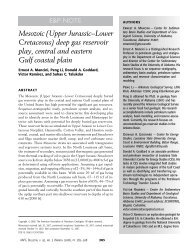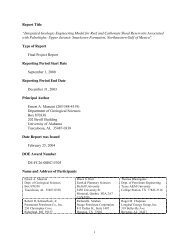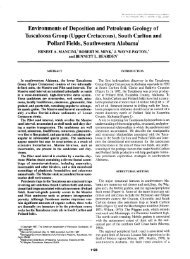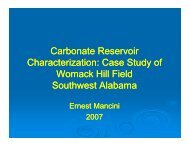Part 4 - Berg - Hughes Center
Part 4 - Berg - Hughes Center
Part 4 - Berg - Hughes Center
Create successful ePaper yourself
Turn your PDF publications into a flip-book with our unique Google optimized e-Paper software.
Sabine, Franklin, Tensas<br />
Shallow water platform Fredericksburg deposition occurred over most of east Texas,<br />
but farther to the east in northern Louisiana the section is partially truncated (Granata,<br />
1963). In northern Louisiana the Middle-Upper Albian Paluxy, Walnut and Goodland<br />
formations are considered part of the Fredericksburg Group. The younger Upper Albian–<br />
Lower Cenomanian Washita Group is truncated and, in some cases, cannot be<br />
differentiated from the Fredericksburg Group in areas of Louisiana. Early workers like<br />
Spofford (1945), placed the Paluxy at the base of Fredericksburg (Walnut clays) and<br />
observed from well study that the Paluxy trended northwest and southeast through Caddo<br />
Parish and northern De Soto Parish. To the west, the Goodland limestone, and the<br />
overlying Washita limestones and shales were also recognized in wells. Cullom et al.<br />
(1962) divided the Washita-Fredericksburg section into a lower Walnut Formation and an<br />
upper Goodland Formation. The former consists of dark shales and dense gray crystalline<br />
to earthy limestones found above the top of the Trinity and the latter unit consists of<br />
porous and non-porous light gray to tan crystalline, fossiliferous shallow water<br />
limestones and interbedded dark marine shales. The top of the Goodland is marked by the<br />
unconformity between beds of Comanchean and those of Gulfian age. According to these<br />
authors, post-Comanchean truncation on the south flank of the South Arkansas Uplift was<br />
cited as being responsible for the erosion of the beds of Washita age. Across the southern<br />
platform area, between 700 and 1,200 ft of Comanchean section is missing due to the<br />
uplift and truncation that accompanied the South Arkansas Uplift. Granata (1963)<br />
reported that the entire Washita Group is only present in a narrow band in east Texas that<br />
trends north into Arkansas but thins east and is no longer present at the north Louisiana<br />
374




